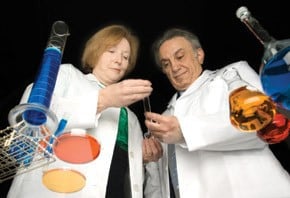Grant to Help Mine Valuable Genetic Data to Improve Cancer Treatments
| March 5, 2010 | As the world leader in treating multiple myeloma patients, the UAMS Myeloma Institute for Research and Therapy houses a treasure chest of momentous data just waiting to be discovered. Thanks to the American Recovery and Reinvestment Act of 2009, a pioneering duo hopes to crack the lid and reveal a gem that could significantly improve the quality of life for patients with the rare cancer. All they needed was the awarding of a National Institute of Nursing Research “GO” grant, so called because they are given in scientific areas the National Institutes of Health identified as “Grand Opportunities.” The primary focus of the two-year, nearly $840,000 grant is to study genes associated with the development of severe chemotherapy-induced mucositis, a common side effect of treatment that strikes about 75 percent of all patients treated, causing ulcers and infection in and around the mouth or anywhere along the digestive tract. “Chemo-induced mucositis can prevent patients from getting the drug they need melphalan — that’s a must-have to treat multiple myeloma,” said Elizabeth Ann Coleman, Ph.D., professor in the College of Nursing and College of Medicine at UAMS. “It affects patients from the mouth all the way down the gastrointestinal tract and it can get so severe that we can’t give them the full dose they need.” In the Genes The results of this study, says Coleman, can potentially improve that and cut back on length of hospital stays and number of visits by improving treatment regimens. The Myeloma Institute is the leading referral center for myeloma treatment in the world, leading to a wealth of genomic information readily attainable to complete this study. Coleman says key data — largely in DNA samples — from 1,168 myeloma patients treated at UAMS with a total therapy of melphalan and autologous stem cell transplant will be used to examine what patients might be at more risk to develop mucositis. “We’ll be able to go back and look at all of the side effects patients had from their chemotherapy to ultimately see if we can predict who’s going to get specific side effects from certain treatments on an individual basis,” Coleman said. “Others have looked at one gene at a time, but we’ll be examining the entire genome.” Add a Leg Elias Anaissie, M.D, director of the Myeloma Institute’s Supportive Care Program and Coleman’s co-investigator in the study, said the current model for treatment is based on only two factors – the dose of melphalan itself and the degree of decreased kidney function in the patient. The genetic information culled from this study will add a third leg to that equation, improving upon the current 66 percent predictive model and boosting it as high as 90 percent. “I admit, 66 percent is not nearly good enough and we can do better,” Anaissie said. “With the genomic information we’ll get from this study the formula we can use to prescribe treatments on an individual basis will be vastly improved.” And a simple spreadsheet including all three factors can then be developed to better predict what patients are more apt to get mucositis and how much mephalan physicians can get away with administering. Expanding Genes “Does this patient have something in their genomic background that opens them up to develop blood clots? Why are this patient’s side effects so much worse here?” Anaissie said. “But you can’t say we’re going to initially study everything, and once we have the information we can go from there.” Coleman said another exciting outcome from the study will help answer hereditary questions about multiple myeloma, which accounts for only 1 percent of all cancers. “If there are family members with it then there must be something genetic going on here that I’d like to know about,” she said. “Once we have the data from these genome studies, we’ll have an extremely rich database that other people can also use for further study.” This article also appears in the winter 2010 issue of Seek, the quarterly magazine of the UAMS Winthrop P. Rockefeller Cancer Institute. |
